Ford ‘Escapes’ from mundane SUV compacts
Filed under: Weekly test drives, Autos
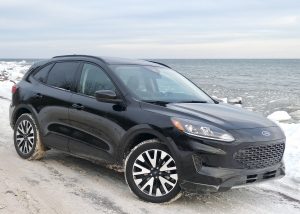
Snow, cold, and the climate of Lake Superior’s North Shore can make you want to escape, and the new Escape is the right vehicle.
By John Gilbert
Sly move, Ford. I capitulate in my questioning of the logic of Ford to not only quit building almost all of its sedans, but to announce it, alerting consumers that maybe they don’t want to risk buying a car that’s going out of existence.
The main reason for my yielding is the 2020 Ford Escape, which is the latest version of the compact SUV that helped trigger our country’s sweeping upsurge to the preference of trucks and SUVs over sedans. While granting that most buyers of SUVs and compact SUVs will stress that they want to be seated a little higher to aid in traffic visibility — and clucking at the certainty that the sightline advantage is pretty well eliminated when you stop at a crowded intersection and notice that 29 out of 30 cars in your field of vision are also SUVs — the new Escape comes very close to merging the best assets of a car and SUV.
We’re all pretty accustomed to the slightly boxy Escape during its formative years and later development, but the new model is much sleeker, much more stylish, and nobody can utter the criticism of it being boxy. There is a definite movement toward sportier and more stylish compact SUVs, with Mercedes, Infiniti, Lexus, and BMW leading the way with lofty standards of styling and technology. The two standards of the segment are the Honda CR-V and the Toyota RAV4, and even they have grown more rounded and stylish, although nowhere near the new Escape’s bold venture.
Ford also has taken an adventurous step in powertrains, leaving its U.S. competitors behind by being first to downsize its engines for fuel economy, and turbocharging them under the heading “EcoBoost” to jack up their power and performance. Others are following now, but Ford put the standard out there and keeps adding refinement.
The test vehicle was the Escape SE Sport AWD Hybrid, which encompasses a lot of technology under those rakish lines. The base Escape now is available with a 1.5-liter 3-cylinder turbo, an engine that is surprisingly capable with its 181 horsepower and 190 foot-pounds of torque, especially in the front-wheel-drive model. Next up, there is a 2.0-liter turbo that has 250 horsepower and 280 foot-pounds of torque that powers the Titanium all-wheel drive model from 0-60 in less than 7 seconds — nearly two seconds quicker than the others. Read more
Chicago Auto Show — best of vanishing breed?
Filed under: Equinox, Autos
By John Gilbert
CHICAGO, ILL.
As February speeds past, car fanciers have until Monday, February 17th to catch a flight or drive to Chicago to get to McCormick Place for the final weekend of the Chicago Auto Show. It remains something of a prize in the diminishing role auto shows are having around the world and in this country.
Those of us in the also-diminishing world of automotive journalists got a chance to attend the preliminary media days last week — two days of previews of what is to come in the public part of the show, last Wednesday and Thursday.
There is not an overwhelming number of new and flashy cars, but certainly enough to keep any car enthusiast on the move for several hours. For highlights, I found the new Ford Mustang Mach E fascinating. Ford has made major headlines about not building cars, eliminating the Taurus, Fusion, Focus and Escort, and continuing on with only the Mustang, and its ever-expanding fleet of trucks and SUVs.
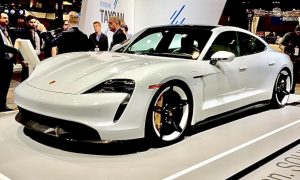
Is it a sports car, or a 4-.door sedan, or an all-electric car? The answer is “Yes,” for the new Porsche Taycan (Photo: Jack Gilbert.)
The Mach E is a pure electric car, and it may hint at how Ford will handle things. Eliminate all those slow-selling cars, and if you want to make an all-new car, go ahead; we’ll just call it a model of the Mustang. The familiar hot-rod pony car remains, of course, in various levels of performance, but the Mach E will be a pure electric car that will run without pistons or valves, using electric rechargeable motors to move on out.
That sets the stage for assorted hybrid and electric models, which even include an all-new Porsche Taycan that blends sports-car, sedan and electric vehicle.
General Motors has pinned its hopes on the flashy new Corvette, with its mid-engine layout, and it has used its considerable promotion and marketing clout to persuade virtually every U.S. entity to name the new Vette as Car of the Year for 2021, despite it being powered by an aging 6.2-liter pushrod V8. Production is just starting on the new Corvette, and it might find its way to showrooms by summertime.
Ford is not resting on its considerable laurels, upgrading the Ford GT, which has It has been around for a decade, and it’s a low-slung, mid-engine, 2-seat sports car, with new power and build-quality called “Liquid Carbon” that will restrict it to only 12 vehicles built per year. Wonder what Henry Ford I would have thought of such elitism. Makes it easy to see what Chevrolet’s real target was for going mid-engine with the Corvette.
We can’t even guess at the car-end of GM’s arsenal, but the SUVs keep on coming. There’s a new Escalade from Cadillac, and midsize Equinox from Chevrolet.
Chrysler, or rather FCA, which is Fiat Chrysler Automobiles, and which has just merged with Renault, to make it a huge and varied conglomerate also goes back to an old familiar nameplate — the Pacifica, which used to be the Caravan. The 2021 Pacifica is coming out in various new forms, including a hybrid, and an all-wheel-drive model that seems made just for us in the Great White North.
Hyundai and Kia are adding to the impressive cars and SUVs they’ve developed, and while the new Sonata gets a hybrid, the Genesis luxury arm of the Hyundai-Kia arrangement adds an all-new luxury SUV, the GV-80.
That will be more than competitive with the newest vehicles from Japan, and from Europe, and all of them are on display at Chicago. The easiest way to tell you what’s there is to show your. My son, Jack, is my trusty photo assistant, and he and I got to just about everything in some way, shape or form, after driving from Minnesota into a blizzard in the Windy City.
So the best way to describe the newest hits of the show is to show them off in photos.
The world of auto shows is undergoing every bit as much upheaval as the auto business this year. Which is plenty. Cars are driving themselves, running silently with electric power, advancing hybrid causes, adding every-more power and handling, and fitting into fewer and fewer cars and more and more trucks and SUVs. And the world’s biggest auto shows — Frankfurt, Los Angeles, Detroit, Chicago, and New York, if you follow the industry closely — are changing just as much.
Meanwhile, the biggest show in the world always has been Frankfurt, and despite having a dozen buildings to house the extravaganza every other year, it will now move to either Berlin or Munich. The Frankfurt show is so impressive it made the world appreciate Frankfurt as something more than a somewhat dreary industrial city. There will be no need to try to promote either Berlin or Munich, two of the world’s most impressive cities.
The result of all this is that the annual February Chicago Auto Show now becomes enhanced as the biggest, from the standpoint of spectators, who will keep clicking the through Monday
Kia deepens its Soul with GT turbo flair
Filed under: Weekly test drives, Autos
By John Gilbert
The 2020 KIA Soul introduces the third generation of the squarish compact sedan, and it is no longer just for fun. It is still plenty enjoyable to drive, and amazingly useful to store stuff in, but after starting life as a bit of a departure, it now has become a staple for the South Korean manufacturer.
When I got the chance to test-drive a 2020 KIA Soul, I was happy to see it was a GT-Line model, in stunning Inferno Red, which is pretty red-orange, and comes pretty well loaded with all the sportiest equipment KIA can put on it. The company logo, by the way, shows “KIA” spelled out in all capital letters, but most folks spell it “Kia,” so we ca sort of alternate, and feel safe.
To new Soul leaves less question. It rides on an all-new platform, something the first two generations never enjoyed, and the GT-Line comes with the standard 2.0-liter 4-cylinder replaced by the smaller but more potent 1.6-liter turbocharged 4. The base Soul has the corporate 2.0-liter 4, without a turbo, and has a fully adequate 147 horsepower and 132 foot-pounds of torque, but taking the smaller 1.6 with a turbocharger, the Soul has 201 horsepower and 195 foot-pounds of torque.
The much of an increase in torque is a huge launch benefit, but beyond the numbers, the peak of 195 foot-pounds comes in at a mere 1,500 RPMs, barely above idle speed, compared to the 4,500 revs it takes the normally aspirated 2.0 to reach torque peak.
The front-wheel-drive compact has a new exterior, too, with a businesslike slacked out grille and LED-underlined headlights, while the rear’s flat facade is highlighted by center-mounted exhaust pipes.
You are surprised that the new Soul has such quickness, with its 7-speed dual-clutch automatic handling the power, and giving you steering wheel paddles if you want to control the shifts manually. Also, that it handles and corners with such firm suspension, but you are more impressed with the interior amenities. For example, the steering wheel lives up to the “GT” phrase, with a comfortably padded leather wrap also getting a flat-bottomed design that gives you a bit more thigh room when entering or exiting. It also has all sorts of remote switches to control audio, cell phone remote, and cruise control.
The seats are supportive buckets, with contrasting red stitching, and the large and wide navigation screen gives you all pertinent information. The floor shifter is joined by a console, and assorted other switches for driving mode and other assets.
All the safety elements are included, too, such as front collision warning and assist, lane keeping assist, adjustable driving mode, and all the connectivity you could want on a contemporary car. I’m not sure if the lesser Soul models have all the same features, and if not, it would be a logical reason the price rises from the low-$20,000 range to $28,710 — the tester’s sticker tally.
Kia, and its corporate partner Hyundai, have made a meteoric rise in quality and design over the past decade, but after joining up with its powerful and successful partner Hyundai, it pretty well paralleled Hyundai, model for model. The Soul was a departure then, because while both companies have neat compacts, Kia got its Soul and there was no parallel version with a Hyundai logo.
American drivers and car-buyers used to be a lot more square, apparently. Remember when Nissan came out with a little square car called the Cube, just about the same time Kia came out with a little square car called the Soul? Even Toyota came out with a square subcompact under its Scion sub-brand, designated by an easily-forgotten combination of large and small letters, while Ford created the Flex, a considerably larger but square vehicle, in keeping with the tradition of U.S. cars being bigger.
The Flex is almost a station wagon/van trucklet, the whole Scion group disappeared, and while the quirky little Cube went away, the Soul remained. The irony of the whole thing is that Kia designed the Soul almost as a novelty, a fun car for younger buyers as a departure from a group of stylish sedans and SUVs. My opinion is that the Soul, too, might have disappeared from the automotive landscape if it weren’t for the hamsters.
Yes, the hamsters. Remember them?
When the first Soul was introduced, the public relations staff showed the assembled media videos of a new ad campaign, showing a couple of cartoon hamsters bopping along in a Solo, heads nodding to the music from the potent sound system. There were two or three different ones, and we all loved them. They became a staple on television commercials for the Soul. The large stuffed hamsters were a cult hit, maybe more than the car itself, but at auto shows and on commercials, the two were interwoven.
Kia public relations folks apologized for using the hamsters, which always puzzled me. Why not flaunt them? But after a couple of years, the hamsters went away, but they had provided the Soul itself with enough marketing traction to go onward and upward, selling much better than even the most optimistic Kia official could have imagined.
I had been invited to attend the introduction of the first Soul, down in Miami. We happened to stay at a neat hotel just off the most populous areas, When I went up to my room on a higher floor of the hotel, I walked along the corridor with a couple of security guards, and we exchanged small talk until I got to my door. When I went to leave a short time later, I was surprised to see the same two security guards two doors down, sitting on folding chairs. Again, we exchanged comments, and I left. At lunch, someone mentioned to me that there was heightened security all around the hotel to prevent photographers from bothering Britney Spears, who was also staying at that hotel, hoping to be secluded while performing a couple of concerts in Miami.
It hit me then that she must be staying next door to me, which was the reason for the guards. The next day we went for our introductory drives in the new Soul, and when we returned in late afternoon, security was more heightened. Nobody was allowed in or out, but I was allowed to go up the elevator to my room to change. Returning to the lobby, I spotted Britney Spears, reclining on a lounge chair by the pool with her infant son and a couple of attendants. I only had a few seconds to snap a couple of photos with my trusty pocket camera, and then we went off for dinner.
Such adventures can leave a lasting impression, and if KIA was not about to incorporate Britney Spears into the Soul’s promotion, it at least could have kept the hamsters. The original Soul was well-suited to any driving requirements in the Miami area, and the new one has advanced enough to be only a small adjustment away from taking care of the challenges of a Northern Minnesota winter.
About the only criticism you might have is that the boxy shape does an effective job of catching the wind, and crosswinds makes you appreciate the vehicle’s stability even while you can hear some wind buffeting. And, I would recommend some top-flight winter tires if you were going to try to make it through a snow-belt winter. The stock, low-profile tires on the test-car’s 18-inch alloy wheels were eager to spin on any icy incline, and a set of Nokians would allow you to frolic through any winter situation.


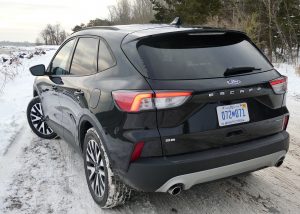
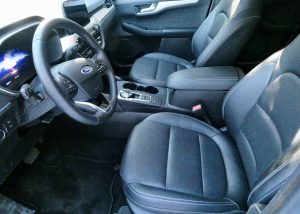
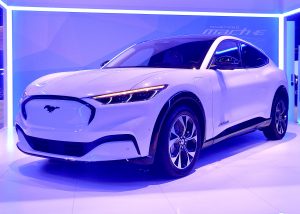
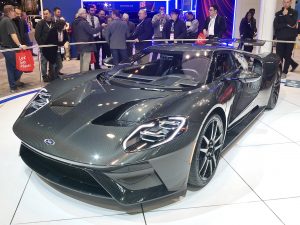
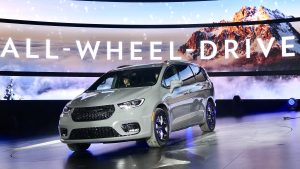
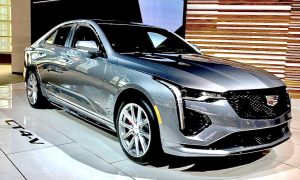
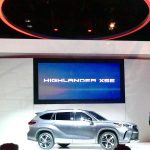
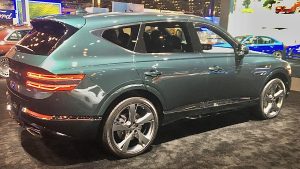
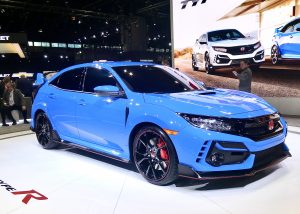
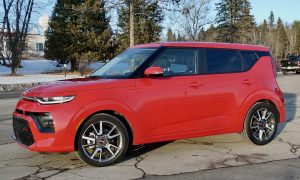
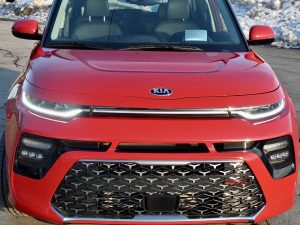
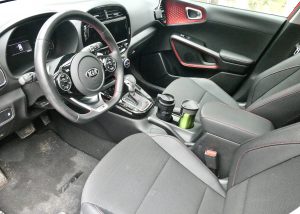
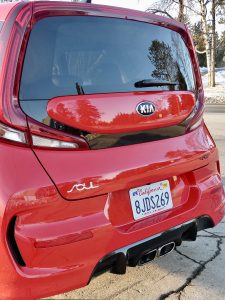
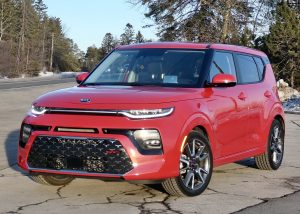
 John Gilbert is a lifetime Minnesotan and career journalist, specializing in cars and sports during and since spending 30 years at the Minneapolis Tribune, now the Star Tribune. More recently, he has continued translating the high-tech world of autos and sharing his passionate insights as a freelance writer/photographer/broadcaster. A member of the prestigious North American Car and Truck of the Year jury since 1993. John can be heard Monday-Friday from 9-11am on 610 KDAL(www.kdal610.com) on the "John Gilbert Show," and writes a column in the Duluth Reader.
John Gilbert is a lifetime Minnesotan and career journalist, specializing in cars and sports during and since spending 30 years at the Minneapolis Tribune, now the Star Tribune. More recently, he has continued translating the high-tech world of autos and sharing his passionate insights as a freelance writer/photographer/broadcaster. A member of the prestigious North American Car and Truck of the Year jury since 1993. John can be heard Monday-Friday from 9-11am on 610 KDAL(www.kdal610.com) on the "John Gilbert Show," and writes a column in the Duluth Reader.